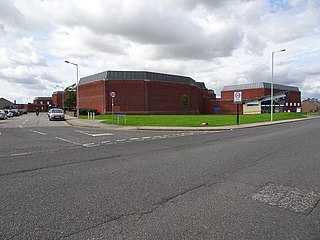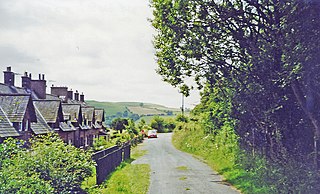
The Buckley Railway was opened from Buckley to a connection with the Chester to Holyhead main line in 7/6/62, to convey coal and finished brickworks products from the Buckley area. Numerous short tramroads had existed in the area from the 1700s. The line was steeply graded and sharply curved.
The Wrexham and Minera Railway or Wrexham and Minera Branch was a railway line in North Wales between the town of Wrexham, the village of Brymbo where it served the Brymbo Steelworks, and the lead mines and limeworks at Minera. A further branch ran from Brymbo to Coed Talon, where it connected with lines to Mold. The system was constructed in several stages between 1844 and 1872, while the various lines making up the system closed in 1952, 1972 and 1982.
Wheatsheaf Junction was the name given to the location where a branch of the North Wales Mineral Railway to Brymbo connected with Shrewsbury and Chester line between Wrexham and Gresford.

The Moss Valley is an area and country park in Wrexham County Borough, Wales. The area, informally known as "The Moss" and The Aggey by local people, has an extensive coal mining history.

Brymbo is a village and community in Wrexham County Borough, Wales. It lies in the hilly country to the west of Wrexham town, largely surrounded by farmland.
Summerhill is a semi-urban village in the suburbs of Wrexham, Wales and forms part of the community of Gwersyllt.

Ffrith is a small village in the community of Llanfynydd in Flintshire, north-east Wales.

Coed Talon is a small, formerly industrial village between Leeswood and Treuddyn in Flintshire, Wales. Its name is derived from the Welsh word coed ("wood") and the word talwrn, anglicised to "Talon", meaning a "hillside devoid of trees" or "threshing-floor".

Cymau is a small village situated in the community of Llanfynydd, Flintshire on the edge of the mountains of north-east Wales. Its name is derived from the Welsh word cymau, an old form of the plural for cwm, "valley" or "hollow".

Peterhead railway station was a railway station in Peterhead, Aberdeenshire.
Hook Norton railway station served the village of Hook Norton in northern Oxfordshire, England.

The North Wales Mineral Railway was formed to carry coal and ironstone from the mineral-bearing area around Wrexham to the River Dee wharves. It was extended to run from Shrewsbury and formed part of a main line trunk route, under the title The Shrewsbury and Chester Railway. It opened in 1846 from Chester to Ruabon, and in 1848 from Ruabon to Shrewsbury. It later merged with the Great Western Railway.
The Mold Railway was a railway company that built a line in north-east Wales. The line linked Mold to Chester and it opened on 14 August 1849. The company built a mineral branch line to Ffrith, opened in November 1849. Mold itself was an important regional centre, and contained considerable mineral resources.
Moss Valley branch was a two mile long single track line built by the Great Western Railway in what is now the county borough of Wrexham, Wales. It ran from a junction with the Wrexham and Minera Railway at Moss Valley Junction to Moss Halt via three intermediate stations: Gatewen Halt, Pentre Broughton Halt, and Gwersyllt Hill Halt.
Mold railway station in Mold, Flintshire, Wales, opened on 14 August 1849 as the terminus of a double-track line from the Chester and Holyhead Railway, starting at Saltney near Chester. It was joined in September 1869 by Mold and Denbigh Junction Railway. In January 1892 a line opened between Mold and Coed Talon, which was extended in 1898 to Brymbo.

Brymbo (WMCQR) railway station was a station in Brymbo, Wrexham, Wales. The station was opened on 1 August 1889, closed to passengers on 1 March 1917 and closed completely in April 1956.
The Lodge Halt railway station was a station in Brymbo, Wrexham, Wales. The station was opened on 1 July 1906 and closed on 1 January 1931.

Brymbo West Crossing Halt railway station was a station in Brymbo, Wrexham, Wales. The station was opened on 20 March 1905 and closed on 1 January 1931.

The Brymbo railway branch lines served the rich reserves of coal, iron, limestone and other minerals in an area around Brymbo to the west of Wrexham in Wales. Coalowners and others needed transport to get their products to market and lines were built from the main line into the mineral-bearing area. The topography was difficult and gradients were steep. The Great Western Railway became dominant, but a rival company built a competing line and branches.

Low Gill railway station served the hamlet of Lowgill, Westmorland, England, from 1846 to 1966 on the Lancaster and Carlisle Railway.












